Calciphylaxis Following Parathyroidectomy in Chronic Kidney Disease Patients—Case Report and Literature Review
Abstract
1. Introduction
2. Case Report
3. Literature Review
4. Discussion
5. Conclusions
Author Contributions
Funding
Institutional Review Board Statement
Informed Consent Statement
Data Availability Statement
Conflicts of Interest
Abbreviations
| CUA | calcific uremic arteriopathy |
| CKD | chronic kidney disease |
| KTR | kidney transplant recipient |
| HD | hemodialysis |
| PTx | parathyroidectomy |
| PTH | parathormone |
| Ca | calcium |
| P | phosphate |
| MGP | matrix G1a protein |
| ESRD | end-stage renal disease |
| RRT | renal replacement therapy |
| CKD-MBD | chronic kidney disease-mineral bone disorder |
| DXA | dual X-ray absorptiometry |
| BMD-DXA | bone mineral density-dual X-ray absorptiometry |
| BMP | bone morphogenetic protein |
| iPTH | intact parathormone |
| DM | diabetes mellitus |
| SHPT | secondary hyperparathyroidism |
| STS | sodium thiosulfate |
| NKF-KDOQI | National Kidney Foundation-Kidney Disease Outcomes Quality Initiative |
References
- Liu, Y.; Zhang, X. Early Diagnosis Strategy of Calciphylaxis in Dialysis Patients. Ren. Fail. 2023, 45, 2264407. [Google Scholar] [CrossRef] [PubMed]
- Smith, R.; Bulteel, N.; Alfonzo, A.; Gupta, S. Successful Treatment of Severe Calciphylaxis in a Renal Transplant Patient with Previous Total Parathyroidectomy. J. R. Coll. Physicians Edinb. 2023, 53, 207–211. [Google Scholar] [CrossRef]
- Nigwekar, S.U.; Wolf, M.; Sterns, R.H.; Hix, J.K. Calciphylaxis from Nonuremic Causes: A Systematic Review. Clin. J. Am. Soc. Nephrol. 2008, 3, 1139–1143. [Google Scholar] [CrossRef]
- Chinnadurai, R.; Huckle, A.; Hegarty, J.; Kalra, P.A.; Sinha, S. Calciphylaxis in End-Stage Kidney Disease: Outcome Data from the United Kingdom Calciphylaxis Study. J. Nephrol. 2021, 34, 1537–1545. [Google Scholar] [CrossRef]
- Nigwekar, S.U.; Kroshinsky, D.; Nazarian, R.M.; Goverman, J.; Malhotra, R.; Jackson, V.A.; Kamdar, M.M.; Steele, D.J.R.; Thadhani, R.I. Calciphylaxis: Risk Factors, Diagnosis, and Treatment. Am. J. Kidney Dis. 2015, 66, 133. [Google Scholar] [CrossRef]
- Gallo Marin, B.; Aghagoli, G.; Hu, S.L.; Massoud, C.M.; Robinson-Bostom, L. Calciphylaxis and Kidney Disease: A Review. Am. J. Kidney Dis. 2023, 81, 232–239. [Google Scholar] [CrossRef] [PubMed]
- Nigwekar, S.U.; Solid, C.A.; Ankers, E.; Malhotra, R.; Eggert, W.; Turchin, A.; Thadhani, R.I.; Herzog, C.A. Quantifying a Rare Disease in Administrative Data: The Example of Calciphylaxis. J. Gen. Intern. Med. 2014, 29 (Suppl. 3), 724–731. [Google Scholar] [CrossRef]
- Sanha, V.; Vidori, L.; Pachi, B.C.; Marchezi, L.V.; Meinerz, G. A Rare Case of Post-Parathyroidectomy Calciphylaxis in a Young Patient With End-Stage Renal Disease: A Case Report and Literature Review. Cureus 2023, 15, e42937. [Google Scholar] [CrossRef] [PubMed]
- Liu, Y.; Zhang, X.; Xie, X.; Yang, X.; Liu, H.; Tang, R.; Liu, B. Risk Factors for Calciphylaxis in Chinese Hemodialysis Patients: A Matched Case-Control Study. Ren. Fail. 2021, 43, 406. [Google Scholar] [CrossRef]
- Nagy, E.; Sobh, M.M.; Abdalbary, M.; Elnagar, S.; Elrefaey, R.; Shabaka, S.; Elshabrawy, N.; Shemies, R.; Tawfik, M.; Santos, C.G.S.; et al. Is Adynamic Bone Always a Disease? Lessons from Patients with Chronic Kidney Disease. J. Clin. Med. 2022, 11, 7130. [Google Scholar] [CrossRef]
- Mori, K.; Shoji, T.; Nakatani, S.; Uedono, H.; Ochi, A.; Yoshida, H.; Imanishi, Y.; Morioka, T.; Tsujimoto, Y.; Kuro-O, M.; et al. Differential Associations of Fetuin-A and Calcification Propensity with Cardiovascular Events and Subsequent Mortality in Patients Undergoing Hemodialysis. Clin. Kidney J. 2024, 17, sfae042. [Google Scholar] [CrossRef] [PubMed]
- Wang, D.; Chu, X.L.; Cao, J.H.; Peng, Y.H. Correlation of Serum Klotho, Fetuin-A, and MGP Levels with Coronary Artery Calcification in Maintenance Hemodialysis Patients. Clinics 2024, 79, 100417. [Google Scholar] [CrossRef]
- Wahab, M.A.; Al Kanhal, F. Calciphylaxis after Parathyroidectomy in Chronic Renal Failure. Saudi J. Kidney Dis. Transpl. 2008, 19, 854–860. [Google Scholar]
- Kidney Disease: Improving Global Outcomes (KDIGO) CKD-MBD Update Work Group. KDIGO 2017 Clinical Practice Guideline Update for the Diagnosis, Evaluation, Prevention, and Treatment of Chronic Kidney Disease–Mineral and Bone Disorder (CKD-MBD). Kidney Int. Suppl. 2017, 7, 1–59. [Google Scholar] [CrossRef] [PubMed]
- Poch, E.; Almirall, J.; Alsina, M.; del Río, R.; Cases, A.; Revert, L. Calciphylaxis in a Hemodialysis Patient: Appearance after Parathyroidectomy during a Psoriatic Flare. Am. J. Kidney Dis. 1992, 19, 285–288. [Google Scholar] [CrossRef]
- Oikawa, S.; Osajima, A.; Tamura, M.; Murata, K.; Yasuda, H.; Anai, H.; Kabashima, N.; Matsushima, Y.; Nakamoto, M.; Nakashima, Y. Development of Proximal Calciphylaxis with Penile Involvement after Parathyroidectomy in a Patient on Hemodialysis. Intern. Med. 2004, 43, 63–68. [Google Scholar] [CrossRef] [PubMed]
- Matstusoka, S.; Tominaga, Y.; Uno, N.; Goto, N.; Sato, T.; Katayama, A.; Haba, T.; Uchida, K.; Kobayashi, K.; Nakao, A. Calciphylaxis: A Rare Complication of Patients Who Required Parathyroidectomy for Advanced Renal Hyperparathyroidism. World J. Surg. 2005, 29, 632–635. [Google Scholar] [CrossRef]
- Bonilla, L.A.; Dickson-Witmer, D.; Witmer, D.R.; Kirby, W. Calciphylaxis Mimicking Inflammatory Breast Cancer. Breast J. 2007, 13, 514–516. [Google Scholar] [CrossRef]
- Katikaneni, M.; Lwin, L.; Villanueva, H.; Yoo, J. Calciphylaxis and Subtotal Parathyroidectomy: A Double-Edged Sword. Hemodial. Int. 2013, 17 (Suppl. 1), S33–S36. [Google Scholar] [CrossRef]
- Bashir, S.O.; Aamer, M.A.; Omer, H.A.; Morsy, M.D. Penile Calcific Uremic Arteriolopathy Occurring Postparathyroidectomy in a Hemodialysis Patient. Saudi J. Kidney Dis. Transpl. 2016, 27, 1265–1269. [Google Scholar] [CrossRef]
- Karmegam, S.; Shetty, A. Calciphylaxis after Parathyroidectomy. Hemodial. Int. 2017, 21 (Suppl. 2), S62–S66. [Google Scholar] [CrossRef] [PubMed]
- Hristov, I.; Elena, A.; Radu, D. Severe Calcific Uremic Arteriolopathy Lessions and Acute Hypocalcemia after Parathyroidectomy for Secondary Hyperparathyroidism in Haemodialysis Patients: Case Series. Endocr. Abstr. 2023, 90, EP191. [Google Scholar] [CrossRef]
- Nasr, R.; Ghazanfar, H. Parathyroidectomy as a Cure for Calciphylaxis in a Non-Dialysis Chronic Kidney Disease Patient? Am. J. Case Rep. 2019, 20, 1170. [Google Scholar] [CrossRef] [PubMed]
- Roza, K.; George, J.C.; Bermudez, M.; Mehta, Z. Uremic Calciphylaxis #325. J. Palliat. Med. 2017, 20, 424–425. [Google Scholar] [CrossRef]
- Colboc, H.; Moguelet, P.; Bazin, D.; Carvalho, P.; Dillies, A.S.; Chaby, G.; Maillard, H.; Kottler, D.; Goujon, E.; Jurus, C.; et al. Localization, Morphologic Features, and Chemical Composition of Calciphylaxis-Related Skin Deposits in Patients With Calcific Uremic Arteriolopathy. JAMA Dermatol. 2019, 155, 789–796. [Google Scholar] [CrossRef]
- Mizuiri, S.; Nishizawa, Y.; Yamashita, K.; Ono, K.; Naito, T.; Tanji, C.; Usui, K.; Doi, S.; Masaki, T.; Shigemoto, K. Relationship of Matrix Gla Protein and Vitamin K with Vascular Calcification in Hemodialysis Patients. Ren. Fail. 2019, 41, 770–777. [Google Scholar] [CrossRef]
- Panchal, S.; Holtermann, K.; Trivedi, N.; Regunath, H.; Yerram, P. Calciphylaxis: An Analysis of Concomitant Factors, Treatment Effectiveness and Prognosis in 30 Patients. Int. J. Nephrol. Renov. Dis. 2020, 13, 65. [Google Scholar] [CrossRef]
- Hill Gallant, K.M.; Spiegel, D.M. Calcium Balance in Chronic Kidney Disease. Curr. Osteoporos. Rep. 2017, 15, 214. [Google Scholar] [CrossRef]
- Rothe, H.; Brandenburg, V.; Haun, M.; Kollerits, B.; Kronenberg, F.; Ketteler, M.; Wanner, C. Ecto-5’-Nucleotidase CD73 (NT5E), Vitamin D Receptor and FGF23 Gene Polymorphisms May Play a Role in the Development of Calcific Uremic Arteriolopathy in Dialysis Patients—Data from the German Calciphylaxis Registry. PLoS ONE 2017, 12, e0172407. [Google Scholar] [CrossRef]
- King, B.J.; el-Azhary, R.A.; McEvoy, M.T.; Shields, R.C.; McBane, R.D.; McCarthy, J.T.; Davis, M.D.P. Direct Oral Anticoagulant Medications in Calciphylaxis. Int. J. Dermatol. 2017, 56, 1065–1070. [Google Scholar] [CrossRef]
- Musso, C.G.; Enz, P.A.; Kowalczuk, A.; Cozzolino, M.; Brandenburg, V.; Nigwekar, S. Differential Diagnosis of Calciphylaxis in Chronic Dialysis Patients. Int. Urol. Nephrol. 2020, 52, 595–597. [Google Scholar] [CrossRef] [PubMed]
- Chang, J.J. Calciphylaxis: Diagnosis, Pathogenesis, and Treatment. Adv. Ski. Wound Care 2019, 32, 205–215. [Google Scholar] [CrossRef]
- Carsote, M.; Nistor, C. Forestalling Hungry Bone Syndrome after Parathyroidectomy in Patients with Primary and Renal Hyperparathyroidism. Diagnostics 2023, 13, 1953. [Google Scholar] [CrossRef]
- Miedziaszczyk, M.; Idasiak-Piechocka, I.; Wisniewski, O.W.; Lacka, K. A Systematic Review of the Pharmacotherapy of Secondary Hyperparathyroidism (SHPT) in Grades 3-5 Chronic Kidney Disease (CKD). Eur. Rev. Med. Pharmacol. Sci. 2022, 26, 232–239. [Google Scholar] [CrossRef] [PubMed]
- Deen, J.; Schaider, H. The Use of Cinacalcet for the Treatment of Calciphylaxis in Patients with Chronic Kidney Disease: A Comprehensive Review. Australas. J. Dermatol. 2019, 60, e186–e194. [Google Scholar] [CrossRef]
- Negri, A.L.; Bover, J.; Vervloet, M.; Cozzolino, M. New Calcimimetics for Secondary Hyperparathyroidism in CKD G5D: Do They Offer Advantages? J. Nephrol. 2024, 1–7. [Google Scholar] [CrossRef] [PubMed]
- Sprague, S.M. Painful Skin Ulcers in a Hemodialysis Patient. Clin. J. Am. Soc. Nephrol. 2014, 9, 166–173. [Google Scholar] [CrossRef]
- Udomkarnjananun, S.; Kongnatthasate, K.; Praditpornsilpa, K.; Eiam-Ong, S.; Jaber, B.L.; Susantitaphong, P. Treatment of Calciphylaxis in CKD: A Systematic Review and Meta-Analysis. Kidney Int. Rep. 2018, 4, 231. [Google Scholar] [CrossRef]
- Nigwekar, S.U.; Zhao, S.; Wenger, J.; Hymes, J.L.; Maddux, F.W.; Thadhani, R.I.; Chan, K.E. A Nationally Representative Study of Calcific Uremic Arteriolopathy Risk Factors. J. Am. Soc. Nephrol. 2016, 27, 3421–3429. [Google Scholar] [CrossRef]
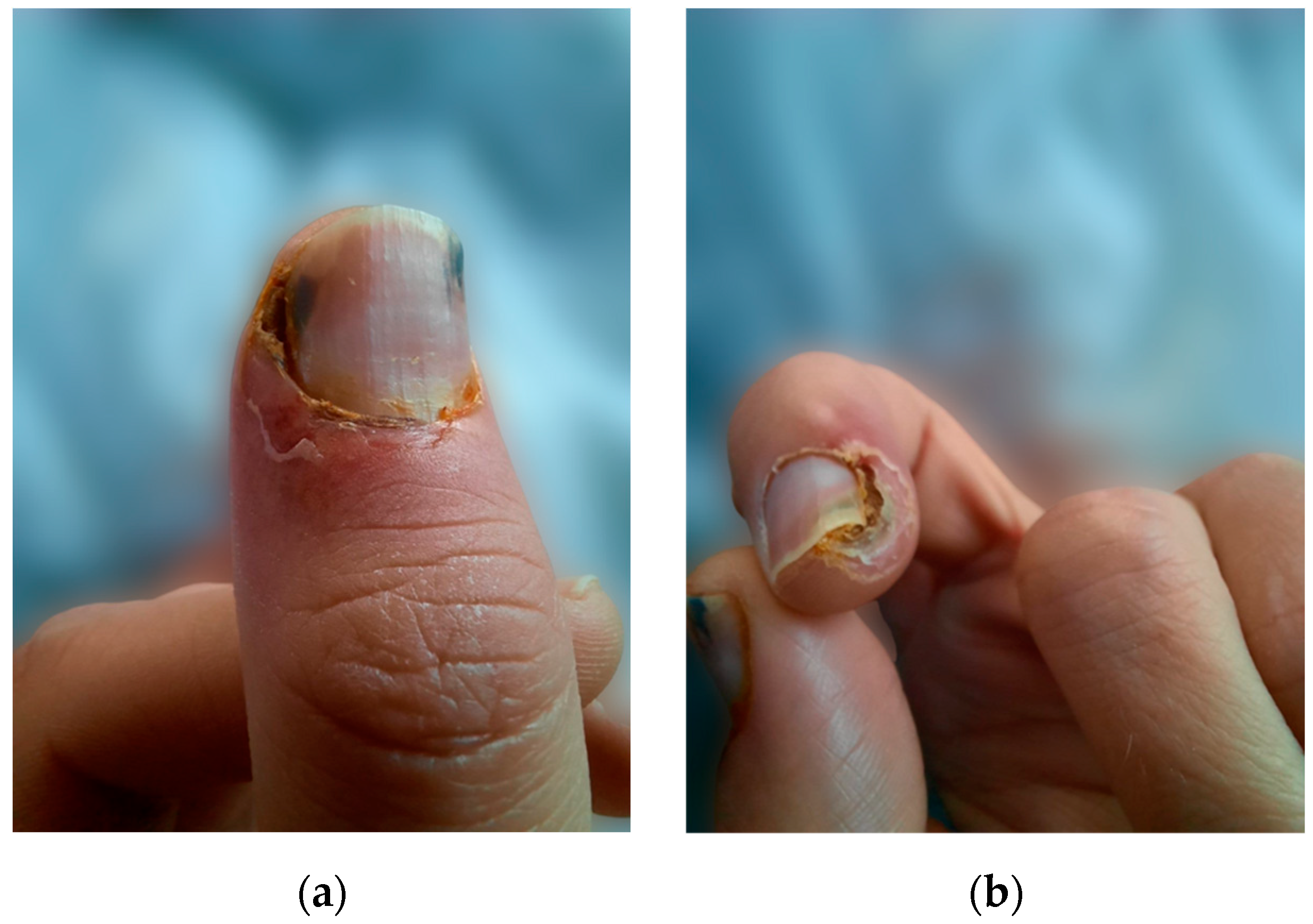
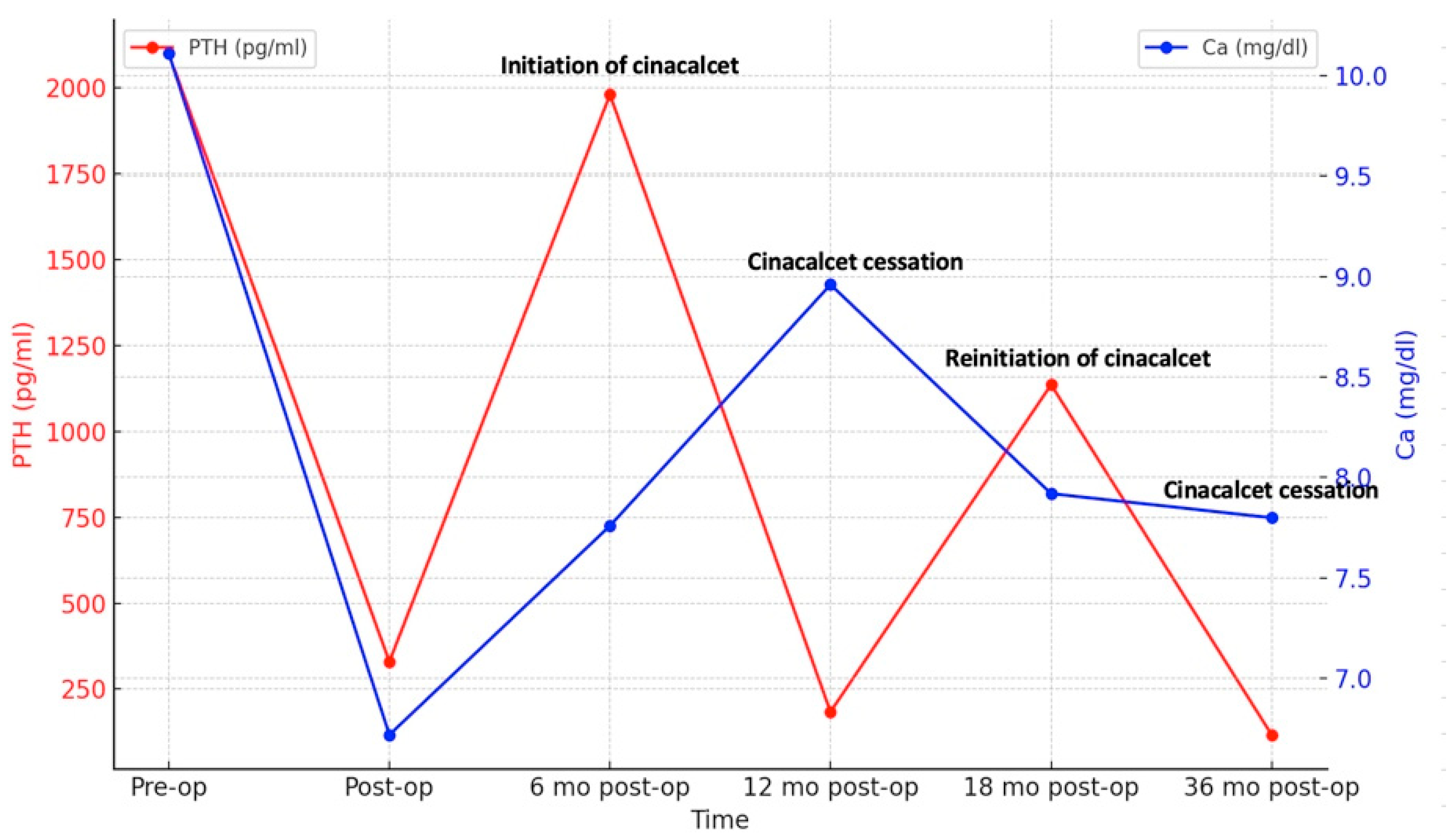
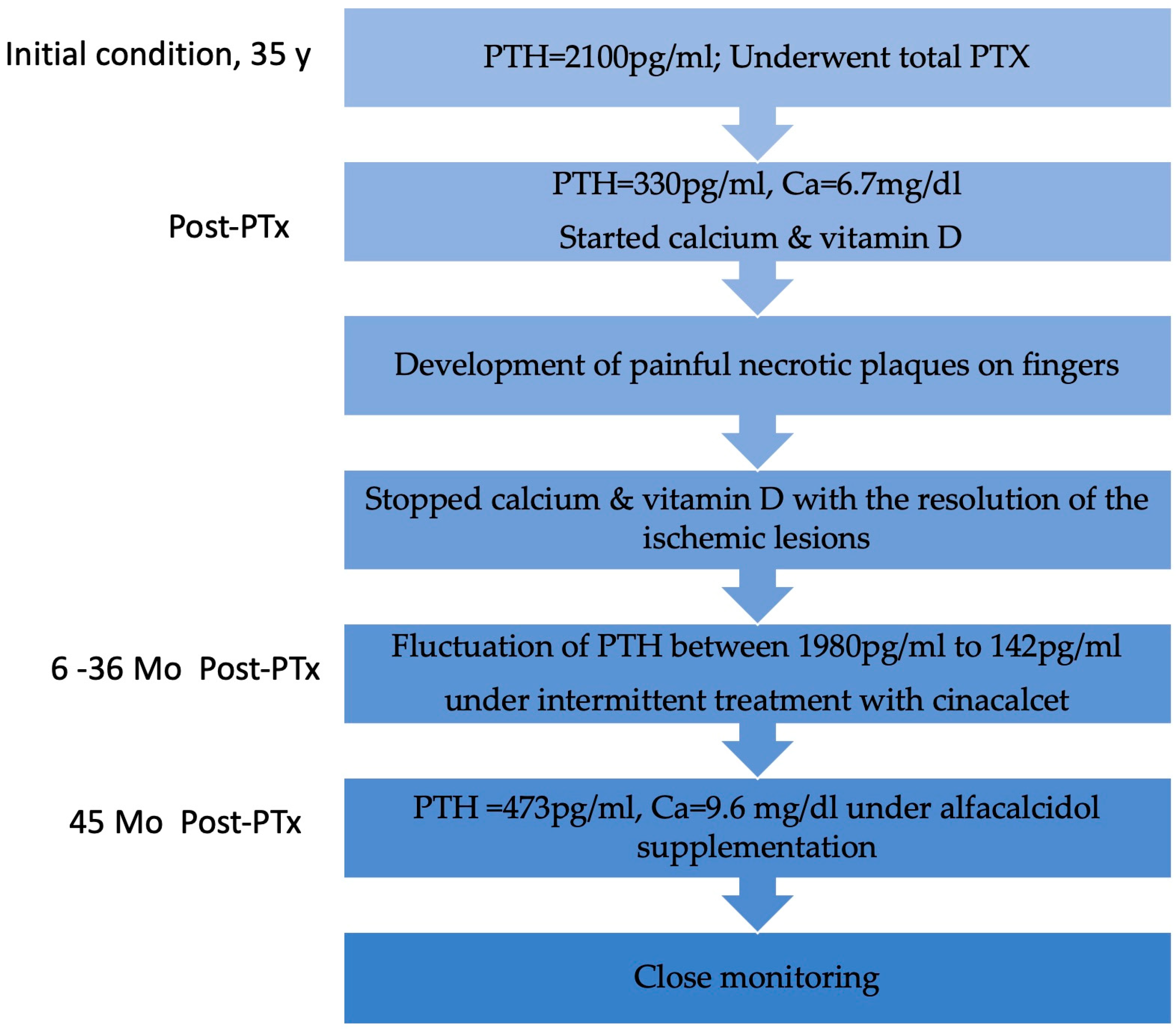
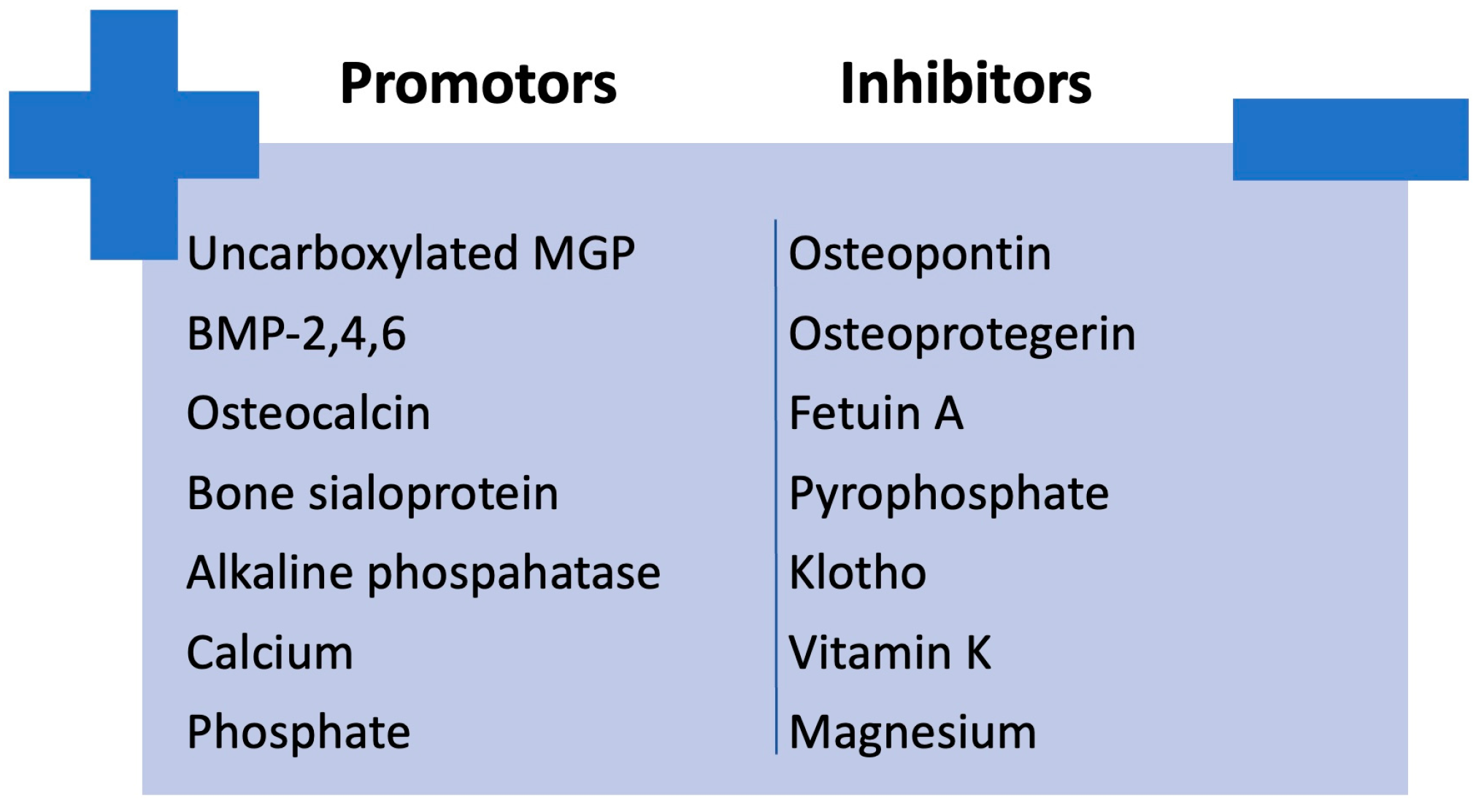
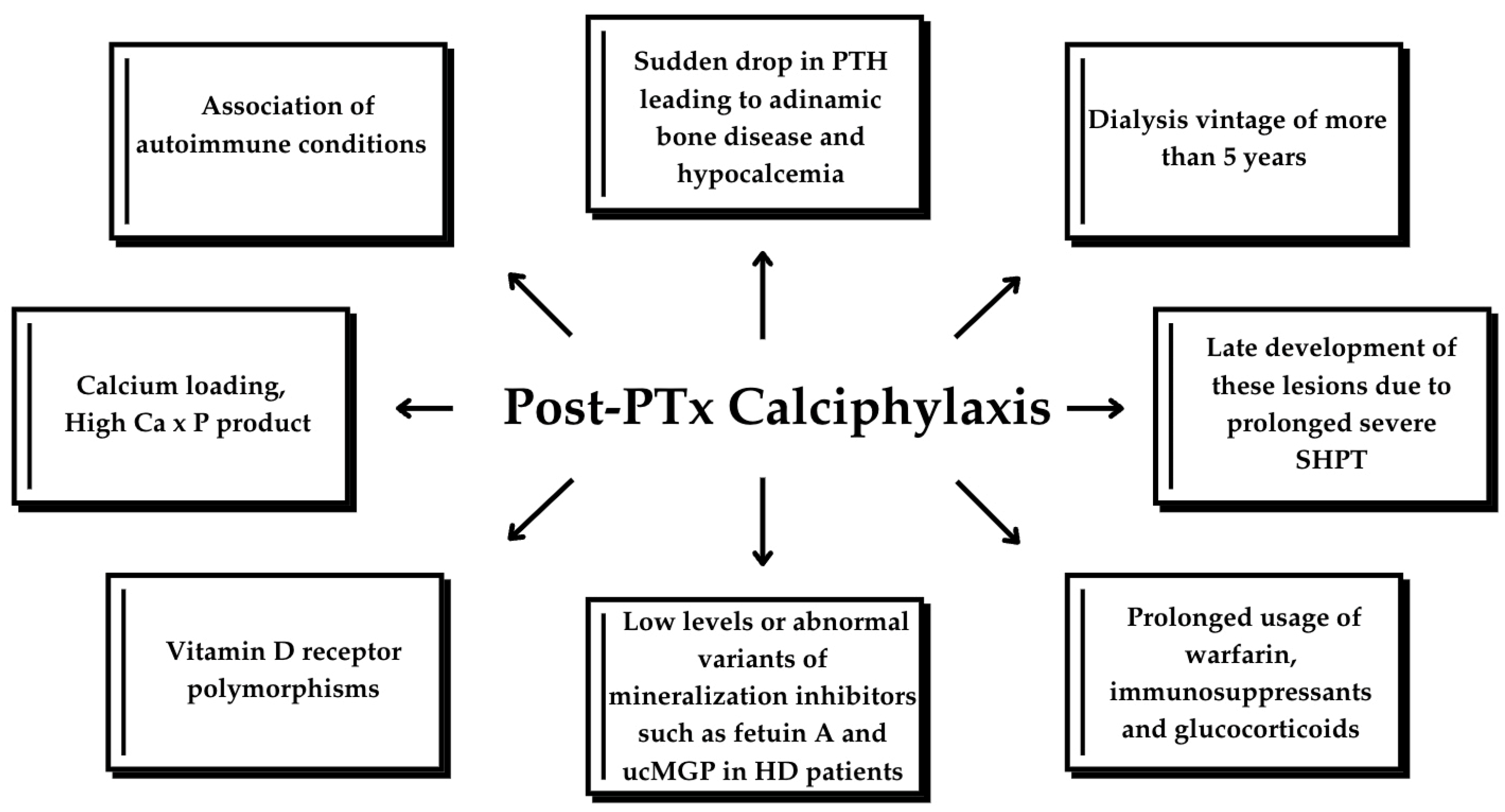
| BMD-DXA | L1-L4 Z-Score | Femoral Neck Z-Score | Forearm Z-Score |
|---|---|---|---|
| 2021 | −1.4 | −1.8 | NA 1 |
| 2024 | −1.3 | −0.7 | −5.8 |
| Author | M/F | Age (y) | Type of RRT | HD/Pdvintage | PTx Indication | Pre-PTx PTH (pg/mL) | Type of PTx | Post-PTx PTH (pg/mL) | Distribution of the Lesions | Time After PTx | Diagnostic Methods | Risk Factors | Therapeutic Approach After PTx |
|---|---|---|---|---|---|---|---|---|---|---|---|---|---|
| Poch et al., 1992 [15] | M | 62 | HD | 8 y | SHPT, severe signs of osteodystrophy | 1205 | Subtotal PTx | 213 | Distal lower and upper extremities | 3 mo | Skin biopsy | Autoimmune conditions, prolonged application of topical therapies for psoriasis; deficiency of protein C; calcium supplementation for hypocalcemia | Calcitriol; calcium supplements; topical treatment for psoriatic lesions; transferred to PD 3 months later |
| Oikawa et al., 2004 [16] | M | 32 | PD-HD | 13 y | SHPT | Unknown | PTx (not specified) | 63 during the onset of symptoms | Back, lower abdominal wall, lower extremities, penile and scrotal involvement | 2 y | Skin biopsy; X-ray; 99mTc-methylene disphosphonate; CT scan | Obesity followed by marked weight loss, corticosteroid medication | Hyperbaric oxygen for whole body; prostaglandin E1; continuous hemodiafiltration and endotoxin absorption; antibiotics; catecholamines; analgesics and narcotics |
| Matstusoka et al., 2005 [17] | F | 57 | HD | 24 y | SHPT | Unknown | Total PTx with forearm autograft | 120 | Lower extremities | Unknown | Skin biopsy | Unknown | Medical and dermatological treatment |
| M | 42 | HD | 15 y | SHPT | Unknown | Total PTx with forearm autograft | 705 | Trunk and extremities | 3 y | Skin biopsy | Unknown | Low calcium dialysate, calcitonin agent, bisphosphonates | |
| F | 48 | HD | 16 y | SHPT | Unknown | Total PTx with forearm autograft | 180 | Lower extremities | Unknown | Skin biopsy | Unknown | Medical and dermatological treatment | |
| Bonilla et al., 2007 [18] | F | 59 | HD | unknown | Calciphylaxis | Unknown | Subtotal PTx | Unknown | Breast | Unknown | Skin biopsy | Anticoagulation (specific type not mentioned) | Fine-needle aspiration; total mastectomy (because of the nonhealing wound and severe breast pain); another PTx |
| Wahab et al., 2008 [13] | M | 33 | HD | 9 y | SHPT | 3489 | Subtotal PTx | 47 | Distal lower extremities | 7 w | Skin biopsy | Unknown | Dermatological treatment, antibiotics, skin grafting |
| Katikaneni et al., 2013 [19] | F | 62 | HD | 5 y | Calciphylaxis | 1513 | Subtotal PTx | 406 | Breast, thigh, and lower abdominal wall | 16 mo | Skin biopsy | Obesity; DM2; calciphylaxis prior to PTx, calcium supplementation and vitamin D analog for hypocalcemia | 25 g of STS 3 times weekly; high calcium dialysate, sevelamer carbonate |
| Bashir et al., 2016 [20] | M | 46 | HD | 14 y | SHPT, Pathological fractures | 2000 | Subtotal PTx | 891 | Penile | 2 w | CT scan | Calcium supplementation and vitamin D analog for hypocalcemia | Low calcium dialysate; high dose of sevelamer; local antibiotic; traditional treatment (honey, local herbs) |
| Karmegam and Shetty, 2017 [21] | M | 60 | HD | 2.5 y | HPT and osteopenia | 4191 | Subtotal PTx | 184 | Lower extremity and buttocks | 4 w | Skin biopsy | DM2, prednisone usage for pain relief | Wound care; antibiotics; increased duration of HD session; 25 g STS with all HD sessions; high-dose oral calcium and vitamin D supplements; oral opiods, topical lidocaine, gabapentine; prednisone |
| Sanha et al., 2023 [8] | F | 26 | HD | 4 y | Brown tumor due to SHPT | >2000 | Total PTx with forearm autograft | 43 (on the first postoperative day), 118 (4 weeks later) | Distal lower extremities | 3 w | Clinical diagnosis (negative early biopsy) | No risk factors mentioned | Wound care; pain management; antibiotics, STS |
| Hristov et al., 2023 [22] | M | 46 | HD | 8 y | SHPT | >1400 | Subtotal PTx | values of 120–250 | Unknown | Unknown | Unknown | Unknown | Surgical debridement; antibiotics; discontinuation of anti-vitamin K; nutritional support |
| M | 49 | HD | 11 y | SHPT | >1400 | Subtotal PTx | values of 120–250 | Unknown | Unknown | Unknown | Unknown | Surgical debridment; antibiotics; discontinuation of anti-vitamin K; nutritional support | |
| Smith et al., 2023 [2] | F | 60 | KTx | 7 y | SHPT | 396 | Total PTx | <9 | Left lower leg | 3 y | Histopathology | DM, anticoagulation with anti-vitamin K | Limb amputation; STS, discotinuation of anti-vitamin K; vitamin K2 supplementation |
| Our study, 2024 | M | 36 | HD-DP-HD | 16 y | SHPT | 2100 | Total PTx | 330 | Distal upper extremities | 8 w | Clinical diagnosis | Calcium supplementation and vitamin D analog for hypocalcemia | Discontinuation of calcium supplementation |
Disclaimer/Publisher’s Note: The statements, opinions and data contained in all publications are solely those of the individual author(s) and contributor(s) and not of MDPI and/or the editor(s). MDPI and/or the editor(s) disclaim responsibility for any injury to people or property resulting from any ideas, methods, instructions or products referred to in the content. |
© 2025 by the authors. Licensee MDPI, Basel, Switzerland. This article is an open access article distributed under the terms and conditions of the Creative Commons Attribution (CC BY) license (https://creativecommons.org/licenses/by/4.0/).
Share and Cite
Akad, N.; Bilha, S.C.; Apetrii, M.; Akad, F.; Bilha, M.; Hogas, M.; Hogas, S.; Ungureanu, M.-C.; Preda, C.; Covic, A. Calciphylaxis Following Parathyroidectomy in Chronic Kidney Disease Patients—Case Report and Literature Review. Biomedicines 2025, 13, 715. https://doi.org/10.3390/biomedicines13030715
Akad N, Bilha SC, Apetrii M, Akad F, Bilha M, Hogas M, Hogas S, Ungureanu M-C, Preda C, Covic A. Calciphylaxis Following Parathyroidectomy in Chronic Kidney Disease Patients—Case Report and Literature Review. Biomedicines. 2025; 13(3):715. https://doi.org/10.3390/biomedicines13030715
Chicago/Turabian StyleAkad, Nada, Stefana Catalina Bilha, Mugurel Apetrii, Fawzy Akad, Madalina Bilha, Mihai Hogas, Simona Hogas, Maria-Christina Ungureanu, Cristina Preda, and Adrian Covic. 2025. "Calciphylaxis Following Parathyroidectomy in Chronic Kidney Disease Patients—Case Report and Literature Review" Biomedicines 13, no. 3: 715. https://doi.org/10.3390/biomedicines13030715
APA StyleAkad, N., Bilha, S. C., Apetrii, M., Akad, F., Bilha, M., Hogas, M., Hogas, S., Ungureanu, M.-C., Preda, C., & Covic, A. (2025). Calciphylaxis Following Parathyroidectomy in Chronic Kidney Disease Patients—Case Report and Literature Review. Biomedicines, 13(3), 715. https://doi.org/10.3390/biomedicines13030715








